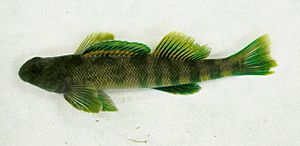Greenside darter facts for kids
Quick facts for kids Greenside darter |
|
|---|---|
 |
|
| Conservation status | |
| Scientific classification | |
| Synonyms | |
|
The greenside darter (Etheostoma blennioides) is a small, freshwater fish. It belongs to the darter group, which is part of the family called Percidae. This family also includes well-known fish like perches.
Greenside darters live in fast-moving parts of rivers and streams, called riffles. You can find them in the eastern United States and southern Ontario.
Contents
About the Greenside Darter
Greenside darters usually live for about three to five years. They can grow up to 5.2 inches (132 mm) long. These fish are ready to have babies when they are one or two years old.
They lay their eggs from February to April in the Midwest and Southeastern United States. The males guard special spots on rocks covered with algae or moss. Females come into the male's area when they are ready to lay eggs. The eggs are sticky and cling to green algae or moss.
Greenside darters are insectivores, meaning they eat insects. They mostly munch on tiny insect larvae like black flies and midges. They also enjoy eating mayfly and caddisfly nymphs.
What Does It Look Like?
Greenside darters have a long body with a rounded snout. Their backs are greenish-brown with dark, square-shaped spots. Their sides have five to eight dark green blotches that often look like U or W shapes.
Their nape (back of the neck), cheeks, and belly are covered in scales. The anal fin usually has eight rays, and the pectoral fin has 13-16 rays. In breeding males, these fins are bright green! Their caudal fins (tail fins) are yellowish or clear. The dorsal fins have 12-15 rays and red bands at their base. Breeding males also have bright bluish-green areas around their nose and mouth.
Where Do They Live?
The different types of greenside darters are thought to have developed in separate river systems. This happened during the Pleistocene ice ages, which changed how rivers flowed.
- The northern greenside darter (E. b. blennioides) lives throughout the Ohio River basin. You can also find it in the Potomac and upper Genesee Rivers.
- The highlands greenside darter (E. b. newmanii) is found in the Cumberland and Tennessee River areas of Alabama, Kentucky, and Tennessee. It also lives in rivers like the Arkansas and White Rivers in Arkansas and Missouri.
- The central greenside darter (E. b. pholidotum) lives in rivers flowing north from the Ozarks. It's also in the Wabash basin, the Maumee River area, and along the shores of Lake Erie and Lake Ontario.
Their Home
Greenside darters love to live in the gravelly, fast-moving parts of large creeks and medium-sized rivers. They are often found in swift waters over big rocks and rubble.
What's in a Name?
The scientific name Etheostoma blennioides has a special meaning:
- Etheostoma: This comes from ancient Greek words. Etheo means "filter" or "strain," and stoma means "mouth." This describes how they eat.
- blennioides: This part means "resembling blennies." The scientist who named it, Constantine Samuel Rafinesque, thought it looked like the blenny fish he knew from his home.
Some of the subspecies also have names with meanings:
- newmanii: This honors Francis H. Newman, a biologist who collected one of the first samples of this fish.
- pholidotum: This means "scaled," because this type of darter has a fully scaled belly.
Keeping Them Safe
Currently, the greenside darter is considered safe across most of its range. However, in Mississippi, their home was changed by the building of the Tennessee–Tombigbee Waterway. This project altered their natural habitat.
Systematics
The greenside darter was first officially described in 1819 by a French naturalist named Constantine Samuel Rafinesque. He found it in the Ohio River. Rafinesque placed this new fish in a new group, or genus, called Etheostoma.
Scientists continue to study greenside darters. For example, some studies suggest that the E. b. newmanii subspecies from the Cumberland and Tennessee Rivers might actually be its own separate species. Also, a former subspecies, E. b. gustelli, has recently been recognized as a full species called Etheostoma gustelli (the Tuckasegee darter).
The greenside darter belongs to a larger group of darters within the Etheostoma genus. This group includes species like:
- E. blennius (blenny darter)
- E. gutselli (Tuckasegee darter)
- E. histrio (harlequin darter)
- E. inscriptum (turquoise darter)
- E. lynceum (brighteye darter)
- E. rupestre (rock darter)
- E. sellare (Maryland darter)
- E. swannanoa (Swannanoa darter)
- E. thalassinum (seagreen darter)
- E. zonale (banded darter)
Etheostoma blennioides is also part of a smaller "greenside darter group." This group includes E. blennius, E. gutselli, E. inscriptum, E. swannanoa, and E. thalassinum.



